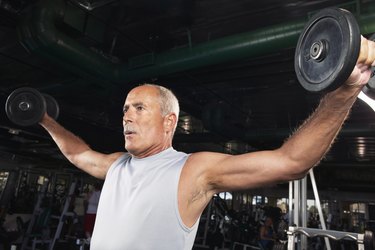
A dumbbell fly is an exercise for your upper body. To allow your elbows to move behind your torso, you should do the exercise on a bench. A dumbbell fly will primarily work muscles in your chest and shoulders; however, it will have some strengthening effect on other muscles in your back and arms as well. If you would like to incorporate some abdominal work, do the exercise on a stability ball.
Movement
Video of the Day
Execute your dumbbell fly with perfect form to ensure you are working the proper muscles. Lie face up on a weight bench. Holding dumbbells in your hands, extend your arms to point up toward the ceiling. Bend your arms slightly, with your palms facing each other. Keep a slight bend in your arms as you arc your arms down, squeezing your shoulder blades together. Lower your fists until they are just above the height of your chest. Because the bend to your arm does not change, your fists should be very wide at the lowest point of the exercise. Slowly return to your starting position. Perform three sets of 12 repetitions.
Video of the Day
Deltoids
One of the main muscle groups worked in a dumbbell fly is your deltoid muscles in your shoulders. Your deltoids start at your shoulder blade and collarbone stretch over your shoulder, attaching to your upper-arm bone. With these muscles you extend, flex and rotate your arm. In everyday life, you use your deltoids to help you lift things. A dumbbell fly works the front and middle parts of your deltoid muscles, with some secondary strengthening of your posterior deltoids in the back of your shoulders.
Pectorals
A dumbbell fly also targets the muscles in your chest. Both your pectoralis minor and major work hard when you are doing a dumbbell fly. Your pectorals start in the middle of your chest and run out toward your shoulder and upper arm. You use them when you move your shoulder to push something or when reaching back to scratch your back. When you are doing a dumbbell fly, you work both of your chest muscles: the larger pectoralis major and the smaller pectoralis minor.
Secondary Muscles Worked
While the main focus of a dumbbell fly is on your chest and shoulders, there is some involvement of the muscles in your arms and back. Your rhomboid muscles, between your spine and your shoulder, get a workout from this exercise. Your serratus anterior muscles, which connect your ribcage to your shoulder, bear some of the load of a dumbbell fly, too. Finally, the muscles of your rotator cuff, associated with your shoulder, and your biceps muscles in your upper arm glean some training benefits from a dumbbell fly.
- American Council on Exercise: Lying Dumbbell Pec Fly
- Sportsinjuryclinic.net: Deltoid
- Sportsinjuryclinic.net: Pectoralis Minor
- Sportsinjuryclinic.net: Pectoralis Major
- Sportsinjuryclinic.net: Rhomboids
- Sportsinjuryclinic.net: Rotator Cuff Injury
- Sportsinjuryclinic.net: Biceps Brachii
- American Council on Exercise: Stability Ball Dumbbell Fly
- Sportsinjuryclinic.net: Serratus Anterior